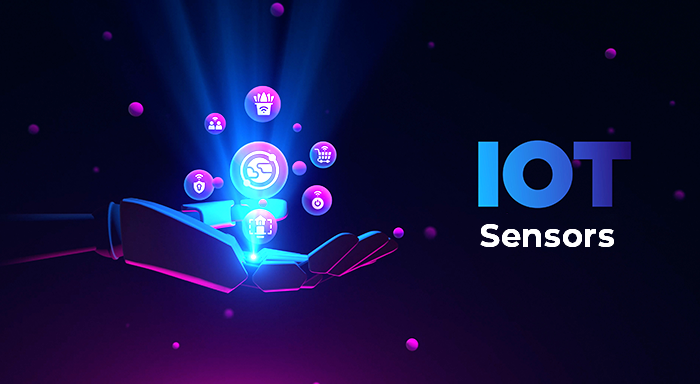Introduction
Today, the popularity of the Internet of Things (IoT) has shifted the paradigm of engaging with technology. One of the subthemes is IoT sensors, an important factor for developing various industries due to the generation of crucial information and automation. They are small and unobtrusive many of them, but they are significant tools that collect data, employ cognition, and facilitate the interconnectivity of devices.
What is a Sensor in IoT
Smart sensors can be defined as IoT sensors that can work in the environment identify alterations in that environment and transmit data to other electrical devices via safe communication protocols in IoT. They are classified into types such as temperature, humidity, pressure, motion as well as light sensors.
Every sensor is applied to control certain conditions of the environment and report this data online so that systems may react to the present circumstances.
The Role of IoT Sensors in Different Industries
IoT sensors are applicable in a broad range of areas across various industries. For example, they monitor patients' clinical indicators and relay information to care physicians, enabling proper clinical action. The farming industry employs sensor systems to measure the moisture content of the soil, temperature, and humidity and therefore, to enhance irrigation results and crop production rates.
In industry and manufacturing, the IoT sensors’ frequent application is in the concept of smart maintenance where products are predicted to fail, and then, maintenance is conducted before this happens.
They can also identify damaged equipment early to reduce the costs of maintenance while at the same time increasing the efficiency of the equipment by knowing the condition of the equipment in real time. The automotive industry also stands to reap big from these sensors especially as they are used to build self-driving cars whereby the sensors work hand in hand feeding the car about its environment to safely steer through.
Also Read
History of IoT: Analyzing the Origins of IoT
Unveiling the Essential Building Blocks of IoT
Learn the Ideas Behind the Logical and Physical Designs of IOT
IoT Communication Models | Connecting the World of Smart Devices
Smart Irrigation System using IoT : Modernizing Water Efficiency
Types of Sensors in IoT
IoT sensors are of different categories and each is special to sense different environmental parameters. Here’s a look at some of the most prevalent types:
1. Temperature Sensors
These sensors measure temperature variation and are employed in smart climate control, industry, and farming.
2. Humidity Sensors
Humidity sensors as its name indicates measure the moisture content in the surrounding air, these are used in climate control types of equipment and especially in agricultural products to maintain the right crop conditions.
3. Pressure Sensors:
These sensors tend to quantify the pressure exerted by anything in the form of a gas or a liquid. They are applied in weather stations, industrial processes, leak detection systems, etc.
4. Proximity Sensors
Proximity sensors are common in mobile phones and vehicular systems where it is used to sense the proximity of an object to the system and perform a particular function based on the distance sensed.
5. Motion Sensors
Used in security systems as well as in automated lighting solutions, the motion sensors work when it comes to movement detection based on infrared or ultrasonic waves.
6. Light Sensors:
These are utilized in gadgets such as the light sensitivity of a screen or in intelligent street lamps.
7. Gas Sensors:
These are important in the detection of hazardous gases in industries' safety and environment and are commonly applied.
8. Infrared (IR) Sensors:
These sensors will sense heat and motion by use of infrared radiation and it is applied in night vision gadgetry and heat-sensitive equipment.
9. Vibration Sensors:
These are integral parts of functional blocks of IoT, employed in condition-based maintenance predictive where the machinery health is monitored by the anomalies of the vibrations.
10. Biometric Sensors:
Present in smart wristbands, for example, Biometric Sensors give information about pulse rate and oxygen saturation, making it easier for a person to track their overall health.
11. Chemical Sensors:
Used in numerous segments, these detect changes in the chemical composition of the air or a liquid which is important in monitoring the environment and for the determination of the quality of air in homes.
12. Accelerometers:
These measure acceleration forces and are used in equipment such as the phone to sense the orientation change and the fitness tracker to count the steps you have made.
13. Gyroscopes:
Combined with accelerometers, gyroscopes measure the rate of rotation and are used in modern automobiles and drones.
14. Level Sensors:
These sensors allow the identification of levels of liquids or solids contained in vessels and find applications in supply chains and dispensing systems.
These diverse types of sensors in IoT are integral to the development of smart technology solutions across various sectors, enhancing functionality and efficiency.
Benefits of Implementing Sensors in IoT
The implementation of IoT sensors offers multiple benefits. Primarily, they provide enhanced data accuracy and efficiency. With continuous data flow, businesses can gain real-time insights, which are critical for making well-informed decisions. Moreover, these sensors can lead to significant cost savings by optimizing operations and resources. For example, smart home systems use IoT sensors to regulate lighting and heating, lowering energy costs.
Furthermore, IoT sensors contribute to improved safety and security. In industrial settings, they can detect hazardous conditions early, enabling preventative measures. Similarly, in smart cities, sensors are used to monitor infrastructure with the help of sensors connected with IoT levels.
Challenges and Future Prospects
While IoT sensors bring numerous benefits, they also pose challenges, mainly concerning data privacy and security. The massive amounts of data captured by these sensors can lead to vulnerabilities if not managed properly. Therefore, implementing robust security protocols is essential.
Looking ahead, the future of IoT sensors is promising, with anticipated advancements in sensor technology boosting their accuracy and integration capabilities. As the demand for smarter technologies grows, so too will the adoption of IoT sensors, continuing to drive innovation across various industries.
Conclusion
In conclusion, IoT sensors are at the heart of the ongoing technological transformation, aiding in the creation of smart environments that are efficient and responsive to real-time data. For industries aiming to stay ahead, embracing IoT sensor technology, while employing effective SEO strategies, will be key to sustaining growth and innovation.
Frequently Asked Questions (FAQs) for Types of Sensors in IoT
How many types of sensors are in IoT?
Numerous types of sensors are used in IoT, including temperature, humidity, pressure, motion, light, gas, and many more. The exact number is difficult to specify as new sensors are constantly being developed.
What is a Temperature sensor in IoT?
A temperature sensor in IoT is a device that measures ambient temperature and converts it into digital data that can be transmitted and analyzed by IoT systems.
What is Sensor Cloud in IoT?
Sensor Cloud is a model for managing and storing sensor data in the cloud, allowing for remote access, analysis, and integration of sensor information from multiple IoT devices.
What is a sensor in IoT?
A sensor in IoT is a device that detects and measures physical properties or changes in the environment, converting them into digital signals for processing and transmission within an IoT network.
What are the different types of sensors in IoT?
1. Temperature sensors
2. Humidity sensors
3. Pressure sensors
4. Motion sensors
5. Light sensors
6. Gas sensors
7. Proximity sensors
8. Accelerometers
9. Gyroscopes
10. Image sensors
From where to buy IoT sensors?
IoT sensors can be purchased from:
1. Web stores (for instance, Amazon marketplace or eBay)
2. Many electronics sellers like Adafruit Electronics Sparkfun Electronics, etc.
3. Specialized IoT suppliers (e.g., Libelium, Digi-Key)
4. From various manufacturers such as Texas Instruments, Bosch, etc.
What sensors are used in IoT and why?
Sensors in IoT are used to capture real-world data to provide a perceived environment so that the devices can decide on a course of action based on the information that has been obtained.
What are the general types of sensors used in IoT?
1. Temperature sensors
2. Humidity sensors
3. Motion sensors
4. Pressure sensors
5. Light sensors
Why are sensors in IoT required?
Sensors are required to:
1. Collect information from the real physical environment in real-time
2. Let devices respond to alterations in the environment
3. Provide inputs for automation and decision-making processes
4. Monitor and control various systems and processes
How do sensors communicate in IoT?
Sensors in IoT communicate through various methods:
1. Wired protocols (e.g., Ethernet, RS-232, RS-485)
2. Short-range wireless protocols (e.g., Bluetooth, Wi-Fi, Zigbee)
3. Long-range wireless protocols (e.g., LoRaWAN, Sigfox, NB-IoT)
4. Cellular networks (e.g., 4G, 5G)



